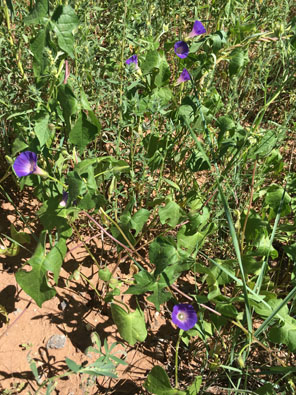
Location
On road from Park Headquarters toward bridge (N35D32'57.360 X W105D41'16.319)
Flowers first observed: 8/16/17
The Plant w/Flowers

The Flower
Distribution
"Found in disturbed sites and in cultivated areas; 1,000-7,500 ft (305-2286 m); flowers from July-November. Distribution: Introduced to much of N. Amer.; in the US from OR south to CA, east to ME and Quebec CAN; south through the W. Indies; MEX, C. Amer., S. Amer.; also on every continent in the Old World." (SEINet)
Description
"Annual, loosely pubescent to tomentose with short, appressed retrorse trichomes, often with large spreading trichomes which may reach 4 mm long, stems twining, branched to simple. Leaves: Blades ovate, entire to 5-lobed, 1-11 cm long, 1-12 cm wide, the base cordate, the apex acute to acuminate, rarely obtuse, mucronate, petioles 1-14 cm long. Flowers: Usually 2-5 flowered cymes, linear to lanceolate bracts, 1.3-9 mm long; pedicels 5-16 mm long, erect in flower, reflexed and enlarged in fruit, to 25 mm long; bracteoles 4.5 mm long; sepals 8-15 mm long, outer sepals narrowly ovate-lanceolate to elliptic, 2.5-4.5 mm wide, acute to abruptly acuminate apically, more pubescent near base, inner sepals ovate-lanceolate, 2.5-3 mm wide, acute to abruptly acuminate; funnelform corollas 2.5-4.3 cm long, blue, white within tube, glabrous, limb 2.4-4.8 cm wide. Fruits: Globose to ovoid capsule 7-8 mm wide." (SEINet)
Ethnobotanical Uses
None Specifically Found
Internet Links